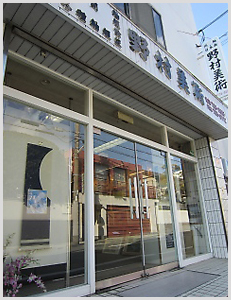make-mounting
- Dec 22, 2025 - Mounting a Scroll of the Pilgrimage: The Largest Class of Nōkyō Scrolls — The Hyakukannon Sacred Sites
- Oct 13, 2025 - Request for Production of a Small-Sized Nichiren Mandala Hanging Scroll
- Oct 06, 2025 - Challenging New Nichiren Mandala Hanging Scroll Commission
- Sep 29, 2025 - Request for Production of a New Type of Nichiren Mandala Hanging Scroll
- Sep 22, 2025 - Lotus-Patterned Brocade for Nichiren Mandala Production
- Sep 15, 2025 - New-Style Nichiren Mandala Hanging Scroll Production
- Sep 08, 2025 - Nichiren Mandala Scrolls to Italy – Making Requests Continue
- Sep 01, 2025 - Another Commission of a Nichiren Mandala from South Africa
- Aug 11, 2025 - Commission for Mounting the Heart Sutra Calligraphic Work into a Kakejiku – A Request from an American Customer
- Aug 04, 2025 - Request for Scroll Mounting of Calligraphy Work from a Customer in America
- Jul 28, 2025 - Custom-Made Shikishi-Kake & Tanzaku-Kake — Consult ART NOMURA
- Jun 10, 2025 - Repeat Order from a U.S. Kakejiku Business: The Fusion of Bonsai Display and Hanging Scrolls
- Jun 01, 2025 - Bulk Order from a U.S. Kakejiku Business – Production of Tanzaku-kake, Shikishi-kake, and Blank Kakejiku
- May 20, 2025 - Custom-Made Kakejiku for an Aikido Dojo in Israel
- May 01, 2025 - Embodying the Spirit of the Shikoku 88 Pilgrimage: A Story of Creating a Kakejiku with Thai Customers
- Mar 20, 2025 - How Overseas Pilgrims Are Experiencing the Shikoku 88 Pilgrimage Scroll Mounting: Missing Stamps and Resolution
- Mar 10, 2025 - Restoring a Damaged Daruma: From Fragile Painting to Beautiful Hanging Scroll
- Mar 01, 2025 - Scroll Repair Request from Australia: Remounting with Unique Roller Ends
- Feb 20, 2025 - Why Repeat Clients Keep Coming Back — A Large-Scale Kakejiku Production Project from Italy
- Feb 10, 2025 - Large Order of 50 Hanging Scrolls from Italian Customer
- Jan 30, 2025 - New Custom-Made Hanging Scroll Order from Italian Customer
- Jan 20, 2025 - Scroll Craftsmen in the Global Era – A Request from Australia for Mounting Zen Monk’s Calligraphy
- Jan 10, 2025 - Custom Kakejiku Order from Switzerland
- Nov 20, 2024 - Eternalize Your Journey: Shikoku 88 Pilgrimage Kakejiku Mounting Service
- Dec 01, 2024 - Calligraphy Work Given by a Deceased Friend to Be Mounted on a Hanging Scroll
- Nov 10, 2024 - Order from a Bonsai Enthusiast in the Netherlands for Tanzaku-gake and Karuta-gake
- Oct 20, 2024 - Repeat Order from a Spanish Customer: Shikishi-gake and Tanzaku-gake
- Oct 10, 2024 - The Next Hanging Scroll Ordered by a British Customer after Saigō Takamori and Hattori Hanzō…
- Oct 01, 2024 - A German Pilgrim’s Request for a Shikoku 88 Temple Pilgrimage Kakejiku Scroll Mounting
- Sep 20, 2024 - A Canadian Pilgrim’s Journey to the Shikoku 88 Temples, Commemorated with a Kakejiku Scroll
Contact Us
Please fill out the form below and submit for your inquiry.
Your privacy is important to us. We are committed to protecting your privacy.
(or press ESC or click the overlay)
CEO Message
(or press ESC or click the overlay)Our Feelings For Kakejiku
Company Profile

Name Art Nomura
President Tatsuji Nomura
Founded1973
Established1992
Address7-23 Babadori, Tarumi-ku, Kobe city,
Hyougo Prefecture, 655-0021, Japan
Capital10 million yen
URLhttp://nomurakakejiku.com
Our Business
Art Nomura is an art dealer which produces kakejiku (hanging scrolls). We mount many paintings and calligraphic works in kakejiku in my factory. Kakejiku are our main product. We also remount and repair old or damaged kakejiku. We share the traditional Japanese art of kakejiku with people all over the world.
(or press ESC or click the overlay)
Access Map
(or press ESC or click the overlay)Access Map
